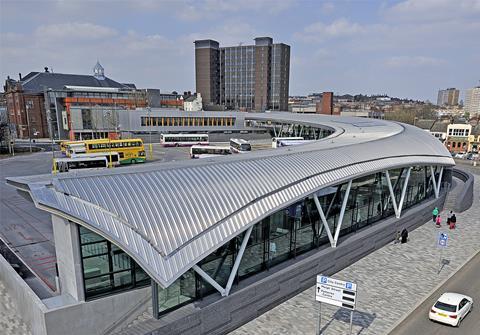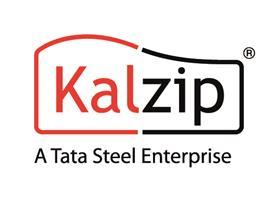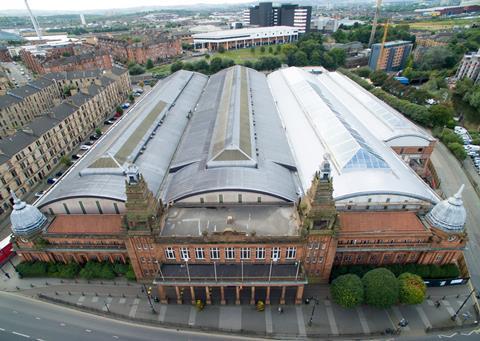This CPD module discusses the use of aluminium standing seam roof and wall cladding systems.
CPD CREDITS: 60 MINUTES
DEADLINE: 12 MARCH 2018
For more information about UBM’s CPD distance-learning programme, click here


INTRODUCTION
This CPD discusses the use of aluminium standing seam roof and wall cladding systems. The original “unhole-y roof” concept was developed in the US in the 1960s, inspired by the efficiency and flexibility of the zips used to fasten clothing. Unperforated sheets of metal were profiled with one small roll standing seam and one large roll standing seam, and secured by placing the sheets over halter clips, with the large roll of one sheet overlapping the small roll of the adjacent sheet. They were then sealed firmly together using a “zipping” machine to close the large roll of the standing seam tightly over the small roll, leaving a secure standing seam. Roll-formed standing seam roofing was first introduced to Europe in 1968, with the opening of a factory in Stuttgart. Today, the concept has evolved and it is possible to achieve complex shapes and geometries, and to use standing seam systems for a range of building roofs and walls.
BUILDING WITH ALUMINIUM
As with any metal, different grades of aluminium are available and it is important that the right grade is specified for each project. The gauge, temper (hardness) and grade of aluminium must be malleable enough for the sheet to be profiled without cracking, but robust enough to withstand the installation process and to provide a long-term weathertight solution. When all relevant variables are considered, typical grades of aluminium suitable for standing seam roof and wall cladding are listed below.
For stucco-embossed natural aluminium:
- BS EN AW-3004 (AlMn1Mg1)
- BS EN AW-3004 (AlMn1Mg1) clad with BS EN AW-7072 (AlZn1) “Alclad”
- BS EN AW-3005 (AlMn1Mg0.5)
- BS EN AW-6025 (AlMg2.5SiMnCu) clad with BS EN AW-7072 (AlZn1) “Alclad”
For a painted finish:
- BS EN AW-3004 (AlMn1Mg1)
- BS EN AW-3005 (AlMn1Mg0.5)
The conditions of each project will influence the profile, gauge, temper and grade of aluminium that is most suitable, and the standing seam manufacturer should be able to provide advice on aspects such as the most suitable alloy.
Adding other elements such as zinc (Zn) and manganese (Mn) to create an alloy can significantly improve performance. In extreme environments, cladding the base material with an additional, sacrificial weathering layer of AW-7072-grade aluminium increases resistance to corrosion and provides greater protection of the building structure.
The process for manufacturing cladding aluminium (Alclad), originally developed for aircraft construction, involves rolling a layer of AlZn1 (aluminium zinc alloy) approximately 5% thick onto the base material under high pressure and at a temperature of approximately 500°C. The materials become welded, meaning that their structural components are so diffused that there is no longer any separating layer.
The improved protection against corrosion is a result of the negative potential of AlZn1 towards the base material of AlMn1Mg1. Where the oxide film of the outer skin is damaged, or at cut edges or drilled holes, the sacrificial layer protects the purer base material electrochemically. Upon appearance of an aggressive medium, the AlZn1 layer “sacrifices” itself by reacting as an anode, allowing the cathode material AlMn1Mg1 to remain intact. Any corrosive pits in the top-sheet will tend to spread horizontally across the sacrificial layer rather than into the core material.
In this way, Alclad almost doubles the expected lifespan of the project. Germany’s Federal Institute for Material Research and Testing (BAM) tested examples of these alloys in three types of aggressive environment: marine, urban and industrial. Even after 40 years of exposure to industrial pollutants and atmospheric attack, BAM found that each roof sheet remained fully functional.
TYPES OF ALUMINIUM STANDING SEAM SYSTEMS
The key to a standing seam roof is the use of a continuous unpenetrated top sheet, made of a durable material. Sheets are “zipped” over the halter clips. The zipping process means there are no fasteners penetrating through the aluminium sheets allowing huge areas of roof to benefit from a continuous and robust impermeable covering.
For most buildings, some penetrations will be required in the roof or walls to allow for elements such as access hatches, vent pipes, louvres and rooflights. Where these must be located mid sheet, it is recommended that the detail is welded, to ensure that the sheet remains impervious.
The metal sheets are held in place with halter clips, which provide the load path to the structure. They can also move in relation to it, accommodating thermal expansion and contraction in the metal sheets. Movement is controlled by the inclusion of a single fixed point, which must be correctly calculated and engineered to counteract considerable in-plane forces caused by longer sheet lengths. Factors to consider include sheet length, pitch, material gauge, snow load and even the colour of the sheet. A fixed-point calculation should be provided for every project. It is imperative that a second fixed point is not introduced.
This is a generic detail for all standing seam systems. The fixed point calculation is not specifically mentioned in British Standards but is covered in MCRMA Technical Paper No.3, Secret Fix Roofing Design Guide, published by the Metal Cladding and Roofing Manufacturers Association.
Liner systems
This is where a non-fragile (ie, walkable) liner is fitted over the structural purlins spanning between rafters, in the same direction as the roof slope from ridge to eaves. A vapour control layer is laid directly over the liner, connected to the substructure by precisely spaced thermally broken halter clips. The end and side laps are taped. This layer is typically formed of polyethylene, and can be reinforced and/or foil-faced depending on the required performance level.
The type and installation method of the vapour control layer is determined by the humidity level of the building. There are five classes of humidity:
- Very low – for example, storage areas
- Low – offices
- Medium – dwellings
- High – high-occupancy dwellings, canteens, sports halls, kitchens
- Very high – swimming pools, breweries, laundries
A condensation risk analysis should be undertaken for most projects to ascertain the correct vapour control layer and sealing methodology. In addition, it is important to take into account any project-specific air leakage requirements, that may be above and beyond British Standard criteria.
Halters or clips are positioned over the purlins in every other trough to suit the profile cover width. This provides a load path from top sheet to structure, and allows thermal movement of the sheet. Thermal insulation is applied directly over the head of each clip to negate the effect of thermal bridging. The aluminium standing seam roofing sheets are installed by positioning the large roll of each sheet over the small roll of the previous sheet and mechanically zipping them together with specialist tools. For removal and reassembly or recycling, sheets can be zipped and unzipped more than once. It is therefore feasible to dismantle an entire roof and resell it ready for reassembly and so is a system that supports circular economic practices.
Deck systems
In these systems, the purlins are replaced by a structural deck spanning across the rafters. The depth of the decking can range between 45-200mm, and the span can be as great as 9m. Deck systems are also typical where there are purlins spanning between rafters, but the aluminium top sheet does not need to follow the direction of the decking. The halter clips can be fixed to the crown of the decking and are not reliant on the purlins. This allows the clips to be installed in a diagonal pattern to create a uniform load for optimal efficiency. The various materials in the roof build up can be specified to meet the project criteria on humidity, thermal performance, airtightness and acoustic performance.
Liner deck systems
As their name suggests, this is a hybrid of the liner and decking systems. The internal layer trapezoidal sheet spans across purlins rather than rafters but is robust enough to provide structural support, meaning that the halter clips can be attached to the crown of the deck. This allows the purlins to be spread out beyond 2m. In a liner deck system, the aluminium standing seam topsheet will run in the same direction as the trapezoidal decking.
Cassette systems
Trapezoidal decking can be replaced by cassettes, narrow overlapping structural trays that work in a similar way to a structural deck spanning between rafters. While they can offer a monolithic ceiling appearance, cassette systems require additional consideration to overcome the inherent difficulties of thermal bridging and air leakage, because they do not provide a solid flat surface for the vapour control to lay on top and seal. The vapour control layer is required to span across the cassette tray and in some instances support the insulation. Care must be taken during installation to make sure that it is not damaged as this may reduce performance of the system in relation to air leakage performance and increase risk of condensation. Since the introduction of Part L2 of the Building Regulations and additional guidance such as Building Bulletin BB93 on the acoustic design of schools, issues such as perimeter sealing and acoustic flanking have led to a reduction in the use of cassette systems. However, with the inclusion of a secondary internal structural layer, they can be as effective as decking or liner systems.

DESIGN CONSIDERATIONS
Standard sheets are typically manufactured in gauges of 0.9mm, 1mm and 1.2mm and a range of profile widths. The most common standing seam systems are supplied in heights of either 65mm or 50mm depending on the architectural intent. The thicker the gauge, the high the seam, and the narrower the profile, the stronger the system will be. Wider profiles use fewer clips and can be more cost-effective, as can thinner gauges.
Thermal performance
Thermal performance is one of the key criteria in deciding the shape and depth of a standing seam roof. With a continuous vapour barrier and a breathable seam, any warm air will rise through the system and be evacuated through the raised seam, which creates a chimney effect. The original standing seam roof concept used a metal clip, creating a cold bridge through the system. Modern clips are designed to prevent this. Polyamide-coated halter clips provide a thermal break. When used in conjunction with standard insulation products, systems can achieve U-values as low as 0.09W/m²K.
Acoustic performance
The required acoustic performance will also determine the depth of the roof system. For additional sound absorption, a perforated inner layer sheet with a tissue-faced acoustic slab directly above it can be specified. The perforated inner sheet facilitates the passage of sound, and the tissue-faced slab absorbs it. The vapour control layer must be placed behind the acoustic slab, or sound will reverberate off it.
Wind loading
Full wind load calculations are critical prior to every project. Factors to consider include the site location, building shape, height, roof pitch and the effect of any adjacent buildings. Calculations should not be presumed to be transferrable between systems. Many feature similar top sheets but the performance of the halter clips can vary greatly.
AESTHETIC POSSIBILITIES
The most straightforward roof shapes are formed using straight, parallel sheets, but it is possible to create patterns even with the simplest system. Sheets can be installed as roofing, and vertically, diagonally and horizontally for walls too. Straight, curved, tapered and free-form profiles can be combined to achieve a great range of designs.
Curved shapes
It is important to assess the manufacturer’s curving parameters when specifying standing seam sheets, as performance varies. As a guide, straight sheets can curve naturally up to a convex radius of approximately 40m and a concave curve to a radius of approximately 50m. Outside of these parameters, sheets can be machine-curved up to a convex radius of approximately 3m and a concave radius of approximately 8m. Curving sheets over a ridge reduces detailing, risk and cost. A single curved sheet can also be used for both wall and roof. For projects where maintenance is problematic, curved sheets can be used to bring gutters to a level at which roof access is not required.
Finishes
Aluminium sheets for standing seam roofs and walls can be produced in many different finishes, such as natural aluminium, copper, stainless steel and a range of coatings. As aluminium is both stable and durable, it can be used as a roofing or cladding material without a protective coating. Sheets can also be perforated to create interesting textural effects. Stucco-embossed natural aluminium diffuses light to create a durable, warm, matt finish. With prolonged exposure to the elements, the original reflective surface will dull to a uniform patina. Changes in appearance will be consistent on every elevation. If colour is required, colour coatings can be specified, including metallic finishes and bespoke colours. Some finishes may require additional coats of colour, primer or UV protection.
Overcladding
Standing seam can be used as a durable base for decorative rainscreen panels, with the standing seam as the waterproof layer and the panels fixed using non-penetrating clamps. Almost anything can be clamped to the seams. Most common are simple aluminium or aluminium composite panels, though timber and even heavy materials such as slate or granite can also be used. This is quicker and more robust than a fully unitised system and does not rely on elements such as gaskets to maintain performance. It is also possible to “overclad” with a sedum green roof.

How to take this module
UBM’s CPD distance-learning programme is open to anyone seeking to develop their knowledge and skills. Each module also offers members of professional institutions an opportunity to earn between 30 and 90 minutes of credits towards their annual CPD requirement.
This article is accredited by the CPD Certification Service. To earn CPD credits, read the article and then click the link below to complete your details and answer the questions. You will receive your results instantly, and if all the questions are correctly answered, you will be able to download your CPD certificate straight away.
CPD CREDITS: 60 MINUTES
DEADLINE: 12 MARCH 2018
Privacy policy
Information you supply to UBM (UK) Ltd may be used for publication and also to provide you with information about our products or services in the form of direct marketing by email, telephone, fax or post. Information may also be made available to third parties. UBM (UK) Ltd may send updates about Building CPD and other relevant UBM products and services. By providing your email address you consent to being contacted by email by UBM (UK) Ltd or other third parties. If at any time you no longer wish to receive anything from UBM (UK) Ltd or to have your data made available to third parties, contact the Data Protection Coordinator at ubmidpa@ubm.com. View our full privacy policy at www.building.co.uk/cpd




























No comments yet